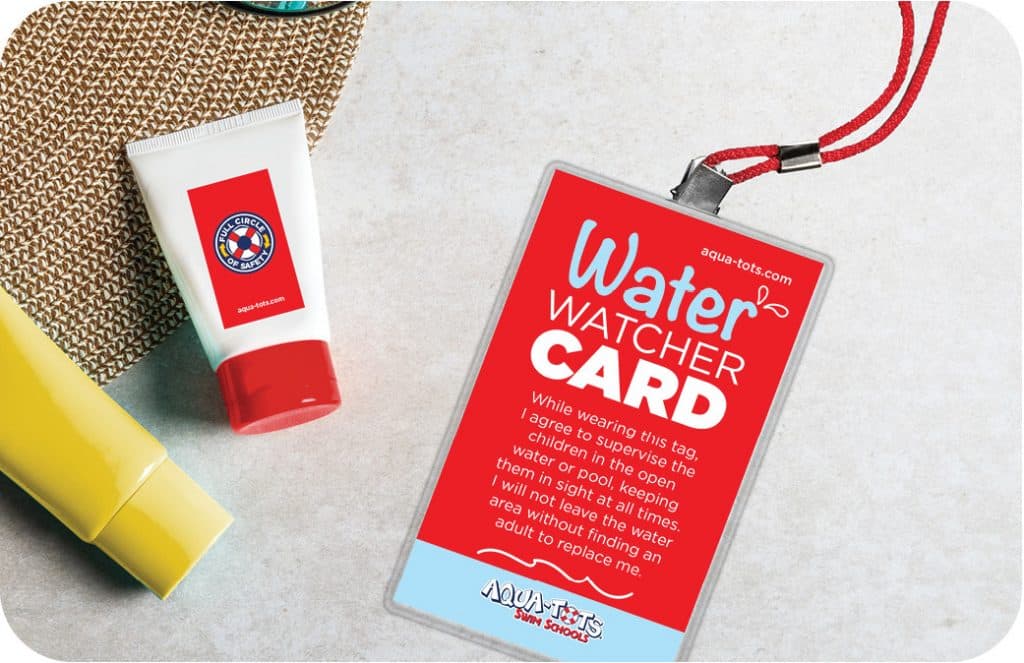The Ultimate Guide to Pool Safety
You’re only cool in the pool when you’re safe. At Aqua-Tots Swim Schools, we’re all about keeping families safe and teaching year-round swim lessons so children of all ages and abilities will grow to become lifelong safe and confident swimmers.
While our cozy, 90° pools are equipped with safety measures and water safety instructors, we want to equip all people with helpful tips for pool safety for kids. According to the CDC, “Most drownings in children ages one to four happen in swimming pools.” Whether you’re in your own backyard, at a friend’s house, a community pool, on vacation or at a hotel, take our Pool Safety Guide with you for added awareness and preparedness.
Download Aqua-Tots’ Ultimate Guide to Pool Safety
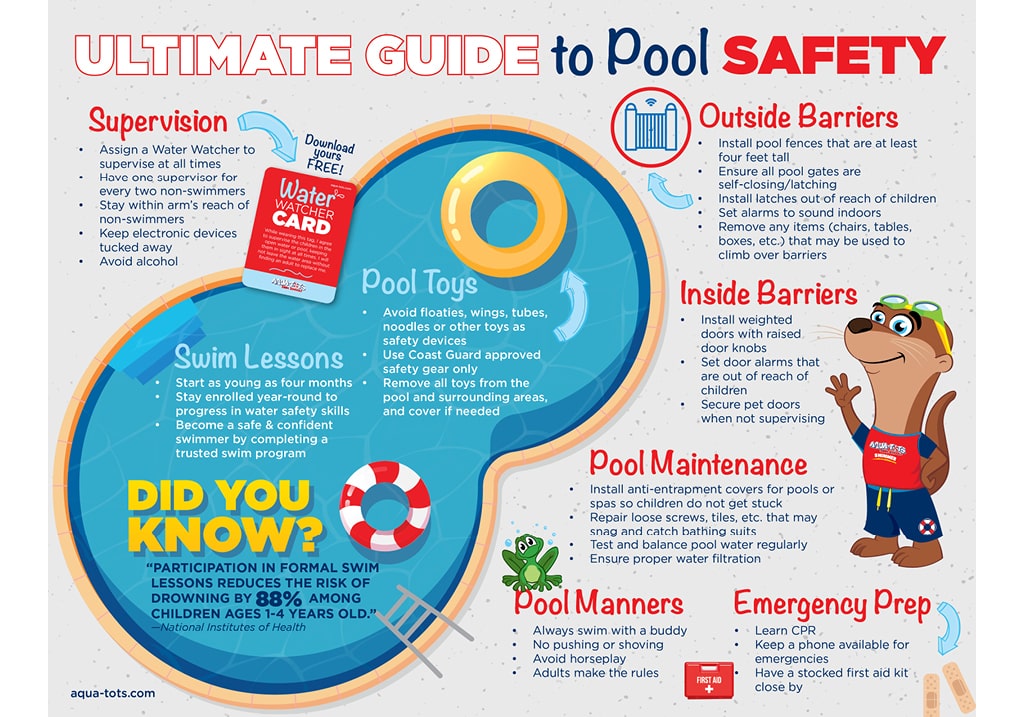
The Best Pool Safety Tips
With 30+ years in the swim instruction industry, we know water and pool safety. In addition to our Ultimate Guide to Pool Safety, here are eight of our best pool safety tips.
Always Supervise Kids Around Water
It should be all eyes on deck—at all times—when young swimmers are in or near the pool. Here is the hard reality around childhood drowning:
- The National Drowning Prevention Alliance finds that, “23% of child drownings happen during a family gathering near a pool.”
- “One out of three parents surveyed have left their child at a pool for two or more minutes without supervision,” according to Safe Kids Worldwide.
- CBS News published, “Nearly half of child drownings happen within 25 yards of an adult.”
Supervision near the pool is imperative for swimming safety for kids, and by supervision, we mean attentive, distraction-free, within arm’s reach attention to young swimmers. For every two non-swimmers in the pool, there should be one adult swimmer who watches, plays and supervises for safe splashing.
Need to remind family members and friends that you’re on patrol and need to stay distraction free? Download our free Water Watcher Card and be the designated memory maker, fun participator and safety keeper for those silly littles—it’s worth it!
Additionally, stay alert, maintain a clear state of mind and remain active by refraining from alcohol while in charge of splashing tots. Save the “Cheers!” for when little ones are tuckered out after a fun, family-filled day of swimming.
Emergency Preparedness Near the Pool
Many layers of swimming pool safety prevent accidents from happening, and preparation is important. A few key factors for preparedness:
- Learn CPR: We encourage all caregivers to learn CPR and know how to perform life saving skills if needed. Dartmouth-Hitchcock Health states, “The single most effective strategy to improve outcomes of childhood drowning is to start CPR as soon as a child is rescued from the water—even before emergency medical services arrive. CPR must begin within minutes of drowning to prevent brain injury and death.” For information on CPR or to take classes visit: American Heart Association CPR Facts & Stats
- Keep a Phone Nearby: Refrain from scrolling, texting or posting while supervising kiddos at the pool, but always keep a phone nearby for emergencies. Teach little ones how to call 911 and have a list of emergency contact numbers available.
- Stock a First Aid Kit: Keep an up-to-date first aid kit on hand and in an easily accessible location for those near the pool. For best practice, replace items if used, discard expired products and keep an up-to-date first aid manual handy.
Safety Barriers, Gates & Fences for Pools
A very important layer to pool safety is physical barriers. Pool gates and fences are the physical protection that will keep curious kiddos safely out of the water. Here are a few facts to unlock the importance of pool gates and fences:
- A Present P. Drowning Study found, “Drowning is a silent killer—most young children who drowned in pools were last seen in the home, had been out of sight less than five minutes, and were in the care of one or both parents at the time.”
- “Wandering is the most commonly reported behavior leading to drowning, accounting for nearly 74% of fatal drowning incidents among children with autism,” according to the American Academy of Pediatrics.
Gates and fences around the pool should be a minimum of four feet high, self-closing, with latches out of reach from tiny tip-toers, and remain locked at all times when adults aren’t actively supervising. Additionally, remove items such as tables, chairs or benches that your bright babes might use to ingeniously climb up and unlatch or unlock gates.
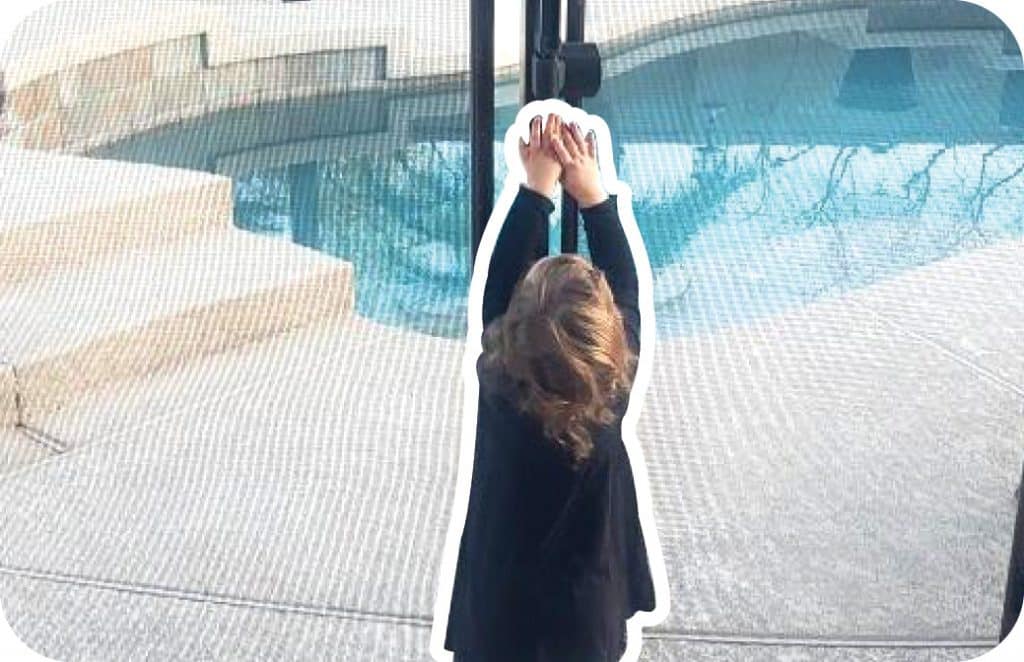
Alarms and Doors for Pool Safety
Similar to gates and fences outside, it’s best to prevent wandering from the inside as well. There are steps that parents, grandparents, friends and homeowners can take to inhibit unsupervised swimming. The first and loudest is an alarm. Arm your interior doors with alarms to sound when they are opened so you are alerted when tiny crawlers or eager splashers head outside unattended. You will be able to jump into action and intercept any unplanned pool visits.
In addition, weighted doors and elevated handles prohibit solo backyard explorations. Although mighty, those pint-sized muscles will be hindered from opening heavy doors, and try as they may, keeping latches and handles out of reach is just another safeguard to keep those precious ones safe. Lastly, keep pet doors secured to prevent small children from climbing through when there are no adults to supervise outside.
Safe Pool Equipment and Maintenance
Teach children and young swimmers to avoid pool drains and play away from them. As the Mayo Clinic explains, “Body parts and hair can become entrapped by the strong suction. Specially designed drain covers, safety vacuum-release systems and multiple drains can prevent entrapment.”
Invest in anti-entrapment covers for your pool and spa drains, and stay on top of pool maintenance. Fix any loose screws, tiles or other parts that could cause injury or snag bathing suits causing a swimmer to get stuck.
Maintain proper water safety levels for pools as well with regular testing and balancing of pool water and ensure proper water filtration.
Best Safety Practices for Pool Floats and Toys
We urge all caregivers to avoid floaties, especially as a lifesaving device in the pool. These arm toys can easily and silently be removed by children and provide a false sense of security for children and adults alike. Similarly, do not rely on pool noodles, inflatables, rafts, etc. to prevent drowning. Instead, invest in Coast Guard approved life preservers.
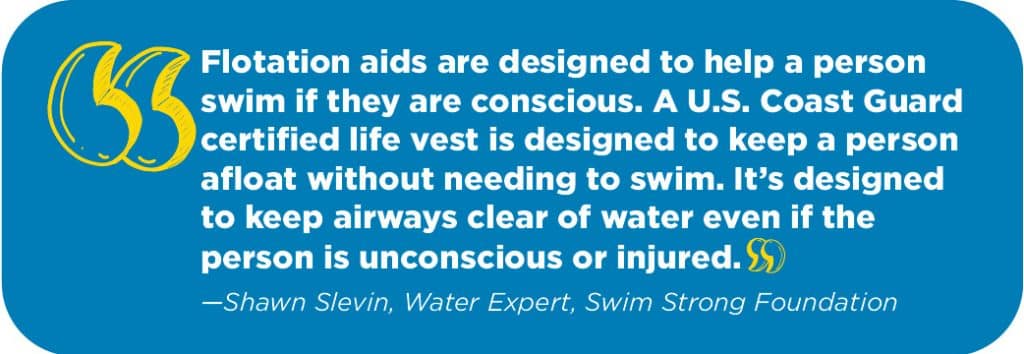
“Flotation aids are designed to help a person swim if they are conscious. A U.S. Coast Guard certified life vest is designed to keep a person afloat without needing to swim. It’s designed to keep airways clear of water even if the person is unconscious or injured.” – Shawn Slevin, Water Expert, Swim Strong Foundation
Speaking of toys, proper storage is key when swimming is finished. Children are drawn to toys, so prevent inquisitive tots from creeping into a dangerous situation by clearing the pool and deck. Just like putting away toys inside the house, train children and family members to clean up after pool use.
The Best Pool Manners for Safety
The pool is synonymous with fun and silly shenanigans, and good pool safety manners should keep it that way. First, remember that safety comes in numbers around the pool. Even for the strongest and most confident swimmers, it is always smart to swim with a buddy. The Red Cross found that, “54% of Americans can’t swim well enough to save themselves.” In case of accidents or injury, having another individual present can be lifesaving. Plus, if you’re alone, who will be the Marco to your Polo?
Secondly, for all rowdy splashers at the pool, do not push or shove anyone into the pool and keep horseplay at a minimum. This will keep timid swimmers from being forced into deep water and will limit accidental injuries.
Lastly, obey the rules set by pool owners, and if it’s your pool, enforce the rules. As an aqua-parent, you now know the best pool safety practices, and it’s your responsibility to keep your pool a fun, safe place to swim.
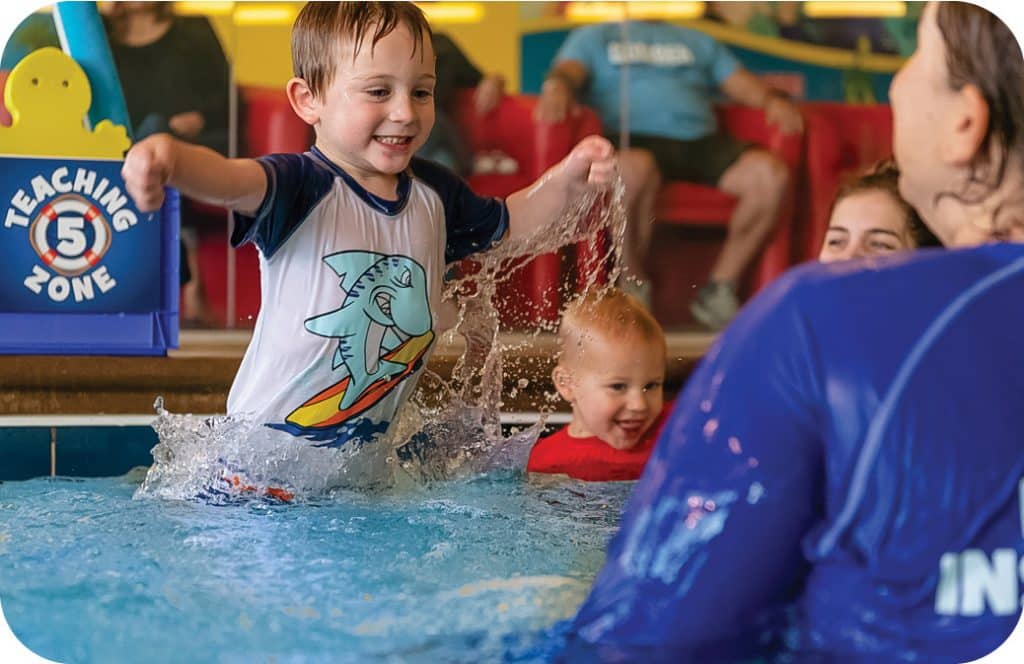
Prepare for Pool Safety with Swim Lessons
With a lifetime of swimming ahead of them, children need to learn how to swim safely. In fact, according to the National Institutes of Health, “Participation in formal swim lessons can reduce the risk of drowning by 88% among children ages 1-4 years old.” Begin swimming lessons as early as four months old to get your baby adjusted to the water. This also gives caretakers extensive know-how when it comes to safe handling of their little one in the water. Establishing boundaries, learning how to find air, roll over, get to the edge and climb out are just a few of the awesome skills that come before swim strokes and technique.
Complete an entire trusted swim program to ensure that your child has all the knowledge they need for a lifetime of safe and confident swimming. Looking to enroll in swim lessons? Aqua-Tots Swim Schools serves families in 120 communities worldwide, and we’re happy to welcome your family to ours. When you pair swim lessons with these pool safety practices, you’ll most definitely be cool in the pool.


 Call Us
Call Us


